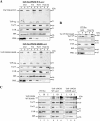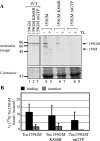A toc159 import receptor mutant, defective in hydrolysis of GTP, supports preprotein import into chloroplasts
- PMID: 19188370
- PMCID: PMC2659226
- DOI: 10.1074/jbc.M804235200
A toc159 import receptor mutant, defective in hydrolysis of GTP, supports preprotein import into chloroplasts
Abstract
The heterotrimeric Toc core complex of the chloroplast protein import apparatus contains two GTPases, Toc159 and Toc34, together with the protein-conducting channel Toc75. Toc159 and Toc34 are exposed at the chloroplast surface and function in preprotein recognition. Together, they have been shown to facilitate the import of photosynthetic proteins into chloroplasts in Arabidopsis. Consequently, the ppi2 mutant lacking atToc159 has a non-photosynthetic albino phenotype. Previous mutations in the conserved G1 and G3 GTPase motifs abolished the function of Toc159 in vivo by disrupting targeting of the receptor to chloroplasts. Here, we demonstrate that a mutant in a conserved G1 lysine (atToc159 K868R) defective in GTP binding and hydrolysis can target and assemble into Toc complexes. We show that atToc159 K868R can support protein import into isolated chloroplasts, albeit at lower preprotein binding and import efficiencies compared with the wild-type receptor. Considering the absence of measurable GTPase activity in the K868R mutant, we conclude that GTP hydrolysis at atToc159 is not strictly required for preprotein translocation. The data also indicate that preprotein import requires at least one additional GTPase other than Toc159.
Figures






Similar articles
-
The targeting of the atToc159 preprotein receptor to the chloroplast outer membrane is mediated by its GTPase domain and is regulated by GTP.J Cell Biol. 2002 Dec 9;159(5):833-43. doi: 10.1083/jcb.200208017. Epub 2002 Dec 9. J Cell Biol. 2002. PMID: 12473690 Free PMC article.
-
The role of GTP binding and hydrolysis at the atToc159 preprotein receptor during protein import into chloroplasts.J Cell Biol. 2008 Oct 6;183(1):87-99. doi: 10.1083/jcb.200803034. Epub 2008 Sep 29. J Cell Biol. 2008. PMID: 18824565 Free PMC article.
-
The roles of toc34 and toc75 in targeting the toc159 preprotein receptor to chloroplasts.J Biol Chem. 2003 Nov 7;278(45):44289-97. doi: 10.1074/jbc.M307873200. Epub 2003 Sep 1. J Biol Chem. 2003. PMID: 12951325
-
Protein transport in organelles: The Toc complex way of preprotein import.FEBS J. 2009 Mar;276(5):1156-65. doi: 10.1111/j.1742-4658.2009.06873.x. FEBS J. 2009. PMID: 19187236 Review.
-
The gateway to chloroplast: re-defining the function of chloroplast receptor proteins.Biol Chem. 2012 Nov;393(11):1263-77. doi: 10.1515/hsz-2012-0235. Biol Chem. 2012. PMID: 23109543 Review.
Cited by
-
Importance of Translocon Subunit Tic56 for rRNA Processing and Chloroplast Ribosome Assembly.Plant Physiol. 2016 Dec;172(4):2429-2444. doi: 10.1104/pp.16.01393. Epub 2016 Oct 12. Plant Physiol. 2016. PMID: 27733515 Free PMC article.
-
Characterization of synthetic antigen binding fragments targeting Toc75 for the isolation of TOC in A. thaliana and P. sativum.Structure. 2023 May 4;31(5):595-606.e5. doi: 10.1016/j.str.2023.03.002. Epub 2023 Mar 27. Structure. 2023. PMID: 36977410 Free PMC article.
-
Import of Soluble Proteins into Chloroplasts and Potential Regulatory Mechanisms.Front Plant Sci. 2017 Feb 8;8:168. doi: 10.3389/fpls.2017.00168. eCollection 2017. Front Plant Sci. 2017. PMID: 28228773 Free PMC article. Review.
-
The molecular basis for distinct pathways for protein import into Arabidopsis chloroplasts.Plant Cell. 2010 Jun;22(6):1947-60. doi: 10.1105/tpc.110.074328. Epub 2010 Jun 18. Plant Cell. 2010. PMID: 20562235 Free PMC article.
-
Common ground for protein translocation: access control for mitochondria and chloroplasts.Nat Rev Mol Cell Biol. 2011 Jan;12(1):48-59. doi: 10.1038/nrm3027. Epub 2010 Dec 8. Nat Rev Mol Cell Biol. 2011. PMID: 21139638 Review.
References
-
- Bruce, B. D. (2000) Trends Cell Biol. 10 440-447 - PubMed
-
- Richter, S., and Lamppa, G. K. (2003) J. Biol. Chem. 278 39497-39502 - PubMed
-
- Oreb, M., Tews, I., and Schleiff, E. (2008) Trends Cell Biol. 18 19-27 - PubMed
-
- Kessler, F., and Schnell, D. J. (2006) Traffic 7 248-257 - PubMed
-
- Jarvis, P. (2008) New Phytol. 179 257-285 - PubMed
Publication types
MeSH terms
Substances
Grants and funding
LinkOut - more resources
Full Text Sources
Molecular Biology Databases

